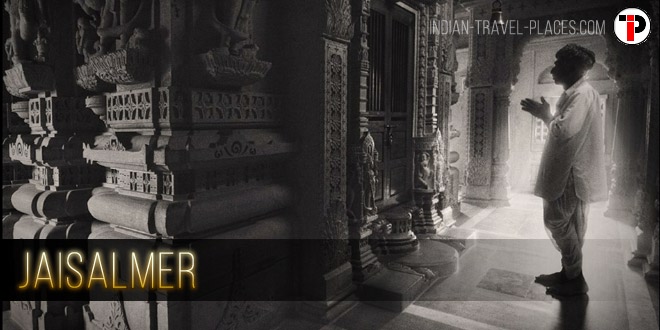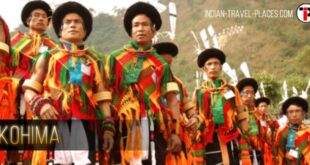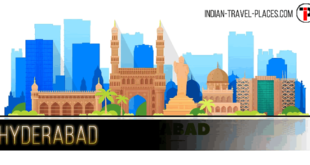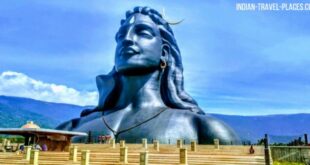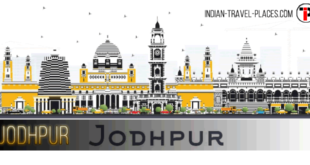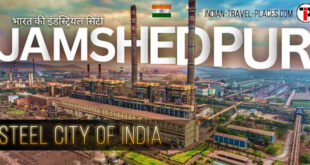Jaisalmer, the “Golden City,” is located on the westernmost frontier of India in the state of Rajasthan. Close to the Pakistan border, the city is known for its proximity to the Thar Desert. A camel safari in the sand dunes of Jaisalmer is an unforgettable experience. The city is dominated by the Jaisalmer Fort, also known as Sonar Qila (Golden Fort). Unlike most forts in India, the Jaisalmer Fort is a living fort. There are shops, hotels and age old havelis (homes) inside the fort area where families have lived for generations.
| Name: | Jaisalmer – Golden City of India |
| Location: | Jaisalmer District, Rajasthan |
| Climate: | Summers: 49° C (Max), 25° C (Min) | Winters: 25° C (Max), 08° C (Min) |
| Best Time to Visit: | October to March |
| Nearest Airport: | Jaisalmer Airport (Domestic airport – located 12.6 kilometres from city centre) |
| Railway Station: | Jaisalmer Railway Station |
| Must Visits: | Jaisalmer Fort, Gadsisar Lake, Jain Temple, Manak Chowk, Nathmalji Ki Haveli, Patwon Ki Haveli and Salim Singh Ki Haveli |
| Language Spoken: | Hindi, Rajasthani and English |
| STD Code: | 02992 |
Jaisalmer is a twinkling city that lies in the heart of the great Indian Thar Desert of Rajasthan. It is also referred to as “The Golden City” of India, because of the presence of yellowish sandstone buildings and the dusky golden surroundings. It is located in Rajasthan, just 575 km away towards the west from the state capital Jaipur. This remarkable city comes under the administrative district of Jaisalmer and serves as home for its headquarters as well. Jaisalmer is spread over an area of about 5 square kilometers, at an elevation of 229 m above the average sea level. Due to such geographical location, this city’s climate can be classified as a very dry one, with scorching hot summers, cool winters and sparse monsoons. Jaisalmer receives an average annual rainfall of just 150 mm. The favorable climatic condition from October to March makes it the best time to visit this historical city.
The city and the famous fort of Jaisalmer were founded by Maharawal Jaisal in the year 1156 AD, after having shifted his capital from Ludharva to a safer place. At that time, Jaisalmer state was under the rule of Bhati Clan of Yadu Rajputs of Chandrawanshi race. According to the legends, the Yadu Rajputs ruled and constructed Forts at Kashi, Mathura, Pragvad, Gajni, Bhatner, Digam, Dirwal, Lodurva and ninth in Jaisalmer. Later in the year 1818, a treaty was signed between Maharawal Moolraj-II and the British government which guaranteed to the ruler and his posterity the principality of Jaisalmer. Post independence, in 1949 Jaisalmer city was merged into the Indian state of Rajasthan. Jaisalmer is one of the most important pilgrim destinations for Jain communities of India, as it houses some of the most beautiful and significant Jain temples, most notable ones being those dedicated to 16th Tirthankar Lord Shantinath and 23rd Tirthankar Lord Parshvanath.
Jaisalmer also houses some of the oldest libraries of India, which contain rarest of the manuscripts & artifacts of Jain tradition. Tourism is a major industry in Jaisalmer, as it has some of the best palaces, havelis and ancient temples which are truly emblems of India’s rich architectural heritage. The desert festival hosted by Jaisalmer, held for three days in the month of January/February yearly, is one of the major festivals of the desert which attracts thousands of foreigner tourists to the city. Some of the prominent tourist destinations of Jaisalmer are Jaisalmer Fort, Gadsisar Lake, Jain Temple, Manak Chowk, Nathmalji Ki Haveli, Patwon Ki Haveli, Salim Singh Ki Haveli, Haveli Shreenath, Desert Culture Centre & Museum and Jaisalmer Folklore Museum. If you want to experience the rustic beauty of India and immerse yourself in Rajasthani traditions and culture, Jaisalmer is the place to be in. And, whilst in the city, don’t forget to visit the sand dunes!
Best Time To Visit Jaisalmer
If you have always been enamored by the vibrant history, culture, festivities and legends of Rajasthan, wait until you set your foot on Jaisalmer and you will know what makes the “Golden City” the real pride of Rajasthan. The very mention of the city of Jaisalmer evokes in our minds an image of endless stretches of golden desert sands, rococo havelis, camel safaris and the historical Jaisalmer Fort. Situated close to the Indo-Pakistan border on the western frontiers of Rajasthan, Jaisalmer edifies itself as an emblem of honor in the checkered history of Rajasthan. Whether you have itchy feet or are a die-hard history buff, Jaisalmer has enough to woo the explorer in you. Surrounded by a vast stretch of sandy waste, this extension of the Great Thar Desert apparently has an extremely dry climate and scanty rainfall, making the atmosphere here a little strained and a hassle for the tourists. Even so, despite of its extremely humid climate, Jaisalmer drives tons of travelers to come and explore its historical heritage. Scroll down further to know more about the best time to visit Jaisalmer and make the most of your trip to this sandy city.
When To Go To Jaisalmer
Weather
Unlike other cities, Jaisalmer mainly experiences two important seasons — summer and winter. Summers in Jaisalmer are searing with mercury levels oscillating between 250 C to 420 C. The months from March to July are unbearably hot. Nights are relatively cooler in summers, bringing a respite from the blistering days. Jaisalmer receives scanty rainfall with occasional cloud burst. Winters in Jaisalmer sets in late October and lasts until February. The temperature here remains pleasurable during this time of the year, making it favorable for the hitchhikers to walk in.
Opting For Your Favorite Season
No matter how much you would love to travel to this city during your summer vacations, its best advised to postpone your travel plans to later months of the year when the weather is more pleasant. Due to the intense stifling heat wave in this region, the weather is most unbearable during summers. However, if you think you can survive the humid climate, then you can definitely hit the city during the early summer months when the heat is comparatively balmier. Don’t forget to carry loads of sunscreen lotions, wide-brimmed hats, and umbrellas for maximum protection from harsh sun rays. Be sure to include excess of mineral water bottles in your bag to avoid being dehydrated or getting sunstroke. For all those who enjoy the cold wintery nights, visiting Jaisalmer during the months of November and January should be an ideal time to experience the chills of the desert land.
Best Time To Visit
The best time to visit Jaisalmer is during winters as the weather condition is most suitable for touring the beautiful palaces, temples, forts and havelis in the city. Winters commences in last few weeks of October and lasts until the end of February. Another reason for you to visit this place during winter is to experience the desert festival in Jaisalmer, which takes place in the month of January or February. The best thing about being a part of this festivity is the opportunity to witness the classic art form- Kalbelia, which is usually expressed in the form of dance. Apart from this, you can also enjoy other forms of folk songs and music that forms an important part of their culture and celebrations.
https://www.youtube.com/watch?v=g5XVDLpwYWc
History Of Jaisalmer
An important place in the southwestern region of Rajasthan, Jaisalmer has a fascinating history to relate. Much of the history of the place revolves around the deeds and feats of the powerful Rajput clan. The Maharawals of this city trace back their lineage to the Bhatti tribe of Punjab who were evicted from their land and had to take refuge in the southern part of Rajasthan. However, things continued to be difficult for them as they were constantly at loggerheads with the influential Rathore. With their constant tussle with Rathore clan, the Maharawal of Jaisalmer realized that defeat was inevitable and gained the help of the British by signing a peace treaty in 1818 to settle the matter. During British India, Jaisalmer experienced severe drought and famine and remained underdeveloped as compared to other parts of the state. During India’s freedom struggle, the barren lands of Jaisalmer surprisingly proved to be a strategic army location. To know more about the interesting details of the history of Jaisalmer, scroll down.
Jaisalmer History
Ancient Descendents Of The Maharawals
In the 9th century, a prince named Deoraj of the Bhatti community and the future founder of the city, was honored with the title of ‘rawal’ meaning ‘of the royal house’. He was said to be engaged to the adjoining chief’s daughter. However, the ceremony failed to take place as his family and followers were slaughtered. Deoraj escaped with a few of his followers and recovered from his tragic loss by constructing the Derawar, and later went on to capture Laudrava, situated a few kilometers away from Jaisalmer. This in turn became the capital of the Bhatti Rajput clan. During this period, the desert land served as the economic hub for the tradesman from Central Asia, Persia, Egypt and Africa who survived on the income earned from camel caravan trade route. As the place was rightly located, it was considered an important economic post. Once the Rathore clan of Jodhpur and Bikaner understood its significance, they raided the place several times to capture the land.
Early Findings Of The City
In the beginning of the 12th century, Jaisal, the eldest son of Rawal of Deoraj, lost the throne of Laudrava to his younger half brother. Jaisal was furious and decided to recapture the capital from his brother. He took the assistance of a Muslim ruler and regained the throne. However, in this process, much of the city was destroyed. Legend has it that Jaisal, while touring around his capital, chanced upon a sage named Eesul who told him about the predictions of Lord Krishna and how a descendent of the Yaduvanshi clan would build his kingdom over here. He also went on to show the spring water created and the divine predictions engraved on the rock by Lord Krishna. After Jaisal’s interaction with the wise man, he decided to move his capital to this area by building the famous Jaisalmer Fort that was named after him.
Medieval Era
In the medieval period, prophesies of the sage came true. The first ‘Sako’ took place in 1294, when the Rawals agreed to pay an annual homage to Delhi Sultan, Alauddin Khilji. However, instead of paying the tribute, the Bhattis irked the Sultan by running a treasure caravan on 3000 horsebacks. The fuming Delhi Sultan sent his forces to capture the Jaisalmer Fort. Rawal Jethsi, the then leader of Jaisalmer, died during the blockade, leaving children, aged people and the sick along with a few armed men to defend the outside walls of the fort. After the death of the Rawal Jethsi, his son Mulraj II succeeded him. By the end of 1294, Mulraj II had exhausted his ammunition and food grains, which left him with little choice but to perform ‘jauhar’. In the first’ jauhar’, more than 24,000 women were killed while the men were slaughtered by the enemy’s sword. The second jauhar took place in the 14th century when one of the prince of Jaisalmer attacked a camp of Sultan Ferozshah near Ajmer. The prince was believed to have stolen Sultan’s most valuable steed. An outraged Sultan raided Jaisalmer, which in turn led to the death of 16000 women along with the Rawal and his son. The half Sako took place again in the 16th century when Amir Ali, an Afghan leader, requested Rawal Lunakaran to arrange for a meeting between his wives and the queens. The palanquins did not have the Afghans ruler’s wives but armed soldiers. The astounded guards of the fort were unprepared for the attack, while Rawal Lunakaran massacred the entire womenfolk. Most of the men were saved as the Rawal received help in defeating Amir Ali.
Jaisalmer Under The Muslim Rule
During the invasion of the Mughal Empire, Jaisalmer did not see much of political unrest in this region except for the battle that took place between Rawal Lunakaran and Humayun. The close relationship that existed between the Maharajas of Jaisalmer and the Mughal leaders began with Rawal Bhim Singh who formed a peace treaty when he gave his daughters in marriage to Prince Salim. The relationship between the Bhatti Rajput and the Muslim rulers only improved when Rawal Sahal Singh supported Shah Jahan in his Peshawar campaigns, which in turn lead to the growth of the caravan trade in this region. Sahal Singh was also able to build his fort and extend his territory, bringing in overall prosperity in this region, despite variance with the Rathors.
British India
During the English rule in the continent, Maharawal Mulraj, who was the chieftain then, signed a treaty with the British in the year 1818 to protect them from invasion and also permit royal succession. In the year 1829, the Maharawal’s of Jaisalmer had to seek out the aid of the British forces in order to end the decade long battle with the Rathors of Bikaner. A few years later, the Maharawal’s heirs also witnessed a personal quarrel with Swarup Singh Mehta, who was the prime minster of the kingdom. He was later beheaded by the king. Meanwhile, his son Salim Singh swore to seek revenge from the members of the royal family. The matter resolved with the death of Salim Singh and fortunately did not require the intervention of the British. During the peak of the foreign rule in India, Bombay emerged as an important seaport in India affecting the trade routes in this district. This in turn led to famine, drought and poverty among the inhabitants of the desert land. Despite of Maharawal Jawahir Singh constant attempts to modernize the place, Jaisalmer failed to improve its economic condition.
Post-Independence
After 1947, the city became a part of Rajasthan. During partition, all trade paths leading to India and Pakistan were closed as the region was considered to be highly sensitive. In turn, Jaisalmer became a strategic location for setting up a military base camp. The construction of paved roads in 1958 and the establishment of the railways in 1968 not only connected this isolated city to the rest of India, but also saw a growth and development in the tourism industry. Jaisalmer is still administered under the Government of India that has provided several welfare activities in the district to revive its economy and the livelihood of the people.
How To Reach Jaisalmer
Arising out of an enormous sandy waste, the “Golden City” of Jaisalmer, swathed in golden sands and dotted with old forts, huge havelis and extravagant temples, tots up as a perfect destination for the globe trekkers. Situated in the westernmost frontier, Jaisalmer is surrounded by Bikaner on the west and Jodhpur on the southeast. A visit to this fascinating city would leave you wonder-struck. The sight of yellow sandstone fort arising out of shimmering sands gives the amber tinted city its legendary ‘golden’ status. Just like the rest of Rajasthan, Jaisalmer too boasts of splendid tourist’s attractions like the Jaisalmer Fort, Rajmahal, Nathmal-ki-Haveli, Gadsisar Lake and more. Once the treasure chest for the Rajputs and an important merchandise center, Jaisalmer still holds name for being the most important trade hubs in the country. The best way to explore the city is by camel rides. However, if you are looking for ways to reach the city, then traveling by rail, road or air could take you to Jaisalmer in great ease.
Traveling To Jaisalmer
By Air
Jaisalmer has an airport of its own, which is located just 5 km away from the city. This airstrip connects the city to other major cities of Jaipur, Jodhpur and New Delhi. However, this airport is under the supervision of the Indian Air Force and functions seasonally during the months of September and March. Therefore, if you wish to travel to Jaisalmer by air, then boarding a flight to Jodhpur and then taking a cab or a bus to Jaisalmer would be a more convenient way to reach the city. Jodhpur airport is situated at a distance of 285 kms away from Jaisalmer and is the next closest airfield to the city.
By Rail
Jaisalmer is connected to Jodhpur by a broad gauge. Many express trains make a regular stopover at the city’s station and connect you to other major cities of Agra, Mumbai, Delhi, Jaipur, Udaipur and many more places. If you are not in a rush and don’t mind spending time travelling in a leisure pace to enjoy the rustic views of India’s country side, then you should definitely book a train ticket to Jaisalmer. However, if you want to experience a hi-end luxury travel, then boarding the ‘Palace on the Wheels’, which makes a customary stopover in Jaisalmer, would take you on a royal ride around the city.
By Road
Jaisalmer boasts of excellent roadways that connects the ‘golden city’ to nearby destinations of Jodhpur, Udaipur, Jaipur, Barmer, Bikaner and even links the conurbation to the cities of Bhuj and Ahmedabad. You can book private buses and even opt for express or deluxe rides to ensure that you reach Jaisalmer in great comfort.
Local Transportation
Whether you wish to travel around the city’s alleyways or explore the town, opting for unmetered auto-rickshaws would take you anywhere in the city in reasonable rates. However, if you are a die-hard adventurer and love to explore the city on your own, then you can hire bikes or jeeps and check out the desertscape on your own. What’s more, you can also avail camel safaris to explore the beautiful desert dunes in Jaisalmer.
Places To Visit In Jaisalmer
With a string of forts, temples, ancient havelis and amber-hued houses scattered around the desertscape, the historical city of Jaisalmer truly stands out as an oasis of beauty for the wanderlusts. Fondly referred to as the “Jewel of the Desert” and the “the Golden City,” Jaisalmer beams with the brilliance of royal elegance. Speckled with architectural splendors in every corner of the city, Jaisalmer is studded with magnificent forts and havelis, which serves as a true testament to the city’s imperial past. Plan a trip to Jaisalmer to explore the glorious past and affluent traditional custom of the city and lose yourself in its royal splendor. Come and explore the desert, its myriad hues, the majestic desert festival, royal mansions, camel safaris and shopping lanes. When in Jaisalmer, don’t forget to check out the bastions as well as the bazaars that gives you a sneak-peek into the local fervor of the land. The main attractions of the city extend from gleaming sandstone citadels to exotic camel shows to its folk dance and music and lots more. To cut the long story short, a trip to Jaisalmer will take you down the glorious chapters of history and unleash true Rajasthan before your peeled eyes.
Tourist Attractions In Jaisalmer
Jaisalmer Fort
The colossal Jaisalmer Fort, situated atop Trikuta Hill, is a spectacular monument established by Raja Rawal Jaisal, a Bhatti Rajput ruler in 1156 A.D. Popularly known as ‘Sonar Quila’ because of its golden yellow sandstone make, this fort displays the subtle fusion of Rajput and Islamic architecture. This living fort, teeming with temples, shops and houses, remains as one of the star attractions of Jaisalmer.
Gadsisar Lake
Gadsisar Lake, a water reservoir sited outside the walls of the city, once served as major source of water for Jaisalmer. This rainwater lake, originally excavated by Maharaja Gadsi Singh in 1367m is truly an oasis for the people of the town. Several small temples and shrines hem this picturesque lake that remains crowded by travelers and devotees all around the year. During winters, the serene beauty of this lake is further enhanced by the migratory birds who flock to this place from all corners of the country.
Nathmalji-ki-Haveli
Nathmalji-ki-Haveli is one of the best architectural constructions in Jaisalmer. This 19th century haveli is widely feted for its exquisite carvings and peerless craftsmanship. This massive haveli, constructed by Hathi and Lalu, blends Rajput and Muslim architectural styles and is a true specimen of its kind. As you enter the haveli, two massive elephant carvings made of yellow sandstone welcome you. On entering this architectural masterpiece, you will be enthralled to see dainty paintings and intricate carvings that adds to the elegance of this marvelous structure. If you want to explore the old glory and majesty of Jaisalmer, then Nathmalji-ki-Haveli is a must-visit place for you.
Tazia Tower
Tazia tower, one of the major tourist attractions of the town, is known for its stunning minarets and architectural fusion. Serving as the integral part of Badal Palace, Tazia tower is a five-storied complex where each floor has its own individualistic designs and royal charm. The stunning complex, beautifully crafted by Muslim artisans, is actually the replica of tombs of various Imams. Made with wood, thermocol and colored papers, the balconies on each floor of the complex are admired for their regal construction.
Patwon-ki-Haveli
Patwon-ki-Haveli, the largest haveli in Jaisalmer, stands in a narrow lane near Patwa complex. With the honor of being first haveli in the town, the place is often flocked by the tourists. The special feature about this building is that it is not a single mansion but a cluster of five small havelis. It is believed that a rich tradesman named Guman Chand Patwa constructed this haveli for himself and his five sons. Presently, the building is occupied by several government offices.
Jain Temple
Noted for their exquisite human and animal figurines, the Jain temple, sited within the Jaisalmer Fort, breathes of superb Dilwara elegance. Erected between 12th to 15th century, the seven elegantly carved temples are dedicated to Chandraprabhu, the eighth tirthankar, Rikhabdev, Parasnath, Shitalnath, Shantinath and Kunthunath.
Shopping In Jaisalmer
Huddled up amidst the vast desert expanse in Rajasthan, the “Golden City” of Jaisalmer is known for its imperial grandeur and classic desert charms. Rising out of the golden sandy deserts, the city promises to leave its visitors enthralled by its architectural marvels, magnificent palaces and typical Rajasthan havelis laced with delicate carvings and ‘jharokas’ or balconies. The scenic landscapes that you see in this whimsical land are good enough to transport you into a dreamy fantasy world. This golden city, embellished with rich cultural heritage, has an endless list of tourist attractions and shopping markets that adds to every traveler’s delight. Shopping along the narrow lanes and browsing through the colorful shops located here is possibly the best way to get close to the city and experience true Rajasthani culture. Wooden boxes with intricate designs, puppets, leather items, hand-woven fabrics are the most sought-after souvenirs in Jaisalmer. Given below is detailed information about shopping places in Jaisalmer that are worth looking around. Check them out.
Shopping Places In Jaisalmer
Bhatia Bazaar
Bhatia Bazaar is one of the liveliest bazaars in Jaisalmer. The market is filled with valuable collection of souvenirs ranging from carved wooden boxes, oil lamps, belts and wallets to table cloths, tapestry, cotton, silk textiles and lots more. The vendors may try to dupe you by charging exorbitant amount of money. So don’t forget to haggle hard and make the best use of your bargaining skills. Shopping in this crowded lane is a wonderful experience and the best part is that the shopkeepers here are dressed in their traditional attires, which are an absolute treat for the eyes.
Sadar Bazaar
Another popular shopping spot in Jaisalmer is Sadar Bazaar that stores both traditional and modern products. The shops are well stocked with a wide array of items like woolen pattu, puppets, blankets, tapestry, carpets antiques, embroidery and many more. Like Bhatia market, even in Sadar Bazaar you can see vendors dressed in their ethnic clothes. If not shopping, at least a walk along this street is highly recommended to experience the real Rajasthan flavor.
Khadi Gramodyog Bhavan
Khadi lovers can try heading out to this shop that is located near the Town Centre Seemagram Campus. Besides shawls, carpets and other woven apparels, you can also shop for embroidered handbags and handcrafted couches at reasonable prices. Khadi Gramodyog Bhavan is kept open from 10:00 am to 6:00 pm on all the days except on Sundays. Other khadi shops present in Jaisalmer are Zila Khadi Gramodan Parishad , Gandhi Darshan Emporium and Jaisalmer Handloom Handicrafts Industries.
Sonaron Ka Bas
Sonaron Ka Bas, whose literal meaning is ‘abode of goldsmiths,’ is the best place to hit if you are looking to splurge in jewelries and other related items. You can find lots of jewelry shops and stalls lined up here that offer a wide range of impressive jewelry products. Women specially throng here to buy silver and gold jewelries of different designs and shapes. Especially in the evenings and during the times of auspicious occasions like family or marriage ceremonies, the crowd at Sonaron Ka Bas peaks high.
Light Of The East
Within the vicinity of the famous Jaisalmer fort, there is this unique shop called ‘Light of the East’ that is stocked with rare and semi-precious stones, forty different varieties of crystals and other mineral specimens. Some of the stones spotted here are aquamarine, onyx, jasper, aventurine, quartz, sandstone, etc. The prices of these stones depend on the quality and the type. A huge piece of apophyllite can also be seen here which still hasn’t found any buyer.
Ramesh Leather Shoe Shop
Leather lovers must check out this small yet fascinating shop located right behind the main fort of Jaisalmer. Besides spotting skilled workers engrossed in creating camel leather products such as chappals, purses, shoes and leather statues of camel, you can also purchase these products at reasonable rates. The pure leather waist belts found here are a must-buy item. So loosen your purse strings and get splurging!
 ITP Indian Travel Places: Food, Travel, Tourism Business Events and Trade Shows
ITP Indian Travel Places: Food, Travel, Tourism Business Events and Trade Shows
